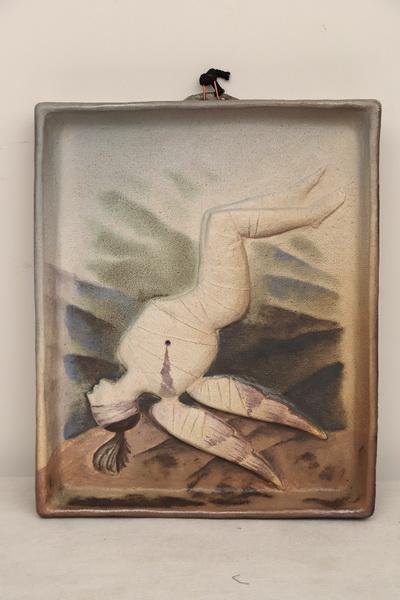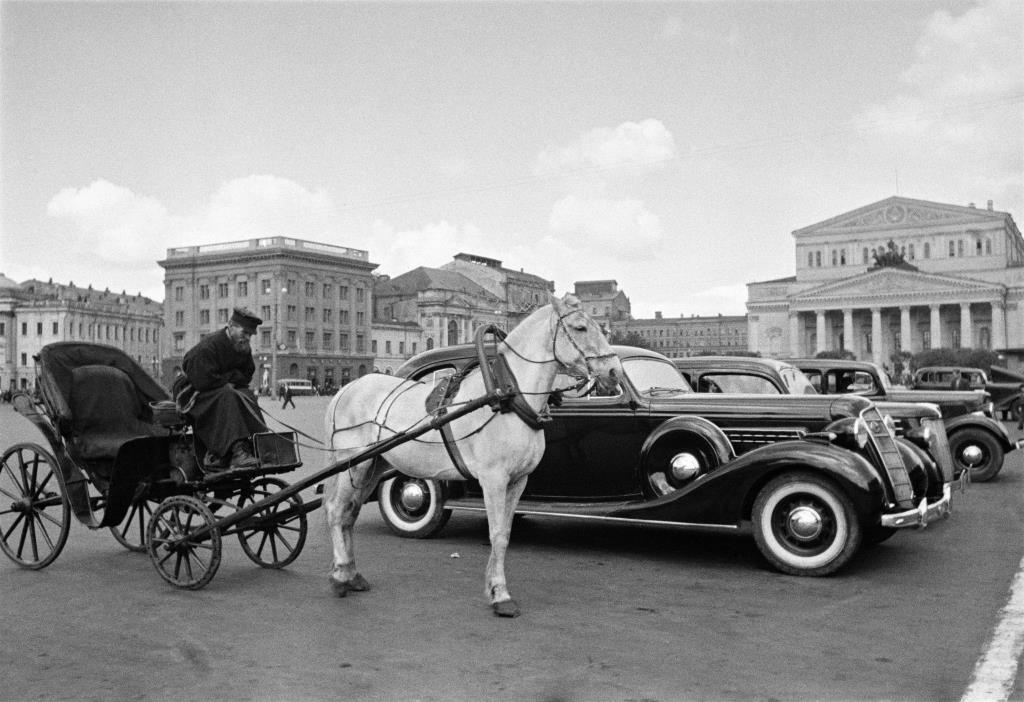
Maloletkov Valery Alexandrovich
Creation period:
1995
Material, technique:
faience, painting
The size:
34.5×29.0 cm
Place of creation:
–
Number in the State Catalog:
16404889
KP number (GIK):
VOKHM KP-9495
Inventory number:
D-1684

Maloletkov Valery Alexandrovich
Creation period:
1972
Material, technique:
chamotte, modeling
The size:
26.0×22.0 cm
Place of creation:
–
Number in the State Catalog:
16404877
KP number (GIK):
VOKHM KP-9492
Inventory number:
D-1681

Maloletkov Valery Alexandrovich
Creation period:
1972
Material, technique:
chamotte, modeling
The size:
28.0×21.0 cm
Place of creation:
–
Number in the State Catalog:
16404863
KP number (GIK):
VOKHM KP-9493
Inventory number:
D-1682

On May 26, the museum will open the third exhibition from the “Opening Funds” cycle, which will present the graphics of the 20s – 30s of the twentieth century from the museum collection.
The aim of the project is to provide a deeper coverage of the artistic features of different periods in the history of Russian art, and to continue acquaintance of visitors with the museum’s collection. The exhibitions thematically and substantively supplement and expand the material of the permanent exhibition, updated in 2020.
The art of the interwar decades developed in a situation of revolutionary transformations. The colorful, diverse artistic life of the 1920s changed significantly in the next decade, when all creative groups, except for those officially established, ceased to exist, and realism, understood more and more unambiguously, was established as an aesthetic basis.
However, even in the most severe years, artists have a space of free creativity – this is a topic of private life, everyday life. Drawings made “for myself”, based on the internal needs of the author, were not intended for wide exposure. They are distinguished by sincerity and lyricism, light irony and genuine interest in what is portrayed. Without heroism and pathos, they affirm the poetry of private human existence. V.A. Milashevsky, in drawings made as if “casually”, in a characteristic spontaneous artistic manner, recorded a moment in the fleeting movement of life. With humor and keen observation, the communal “charms” of the harsh everyday life are noted in the drawing by V.N. Vakidin “Inhabitants of the House” (1934). Modest, devoid of external showiness and any virtuosity, small drawings by K.K. Zefirova convey the calm and natural state of the most familiar things.
One of the central themes in the art of the 1920s and 1930s is the image of a contemporary. It is natural for artists to turn to the portrait genre, in which an attempt is made to combine purely individual features with typical ones, reflecting the social characteristics of the model. The image of the “new man” was romanticized in the watercolor drawings by NS. Troshina, V.A. Zhdanov, their heroes clearly characterize their era, imbued with the pathos of reorganizing the foundations of life. The lyrical note sounds distinctly in N.M. Chernysheva, in the drawings of thin and fragile teenage girls in the charm of the transitional age from childhood to girlhood, full of severity, purity and grace. The transfer of portrait resemblance did not captivate the artist, in his heroines he sought to reflect “the expression of young faces” and “inner excitement by the visions of the opening world” …
A visit to the exhibition is included in the cost of an admission ticket to the main exposition of the museum.
Members of the Union of Artists (upon presentation of a certificate) – free
Photography: mobile devices, camera (without flash) – free
The exhibition will run until July 25, 2021.

June 3 at 4 pm within the framework of the International Platonov Festival of Arts in the exhibition hall of the Voronezh Regional Art Museum. I.N. Kramskoy, the opening of the exhibition “Arkady Shaikhet. Time Witness. Photos 1924-1940 “.
Arkady Shaikhet (born in 1898) arrived in Moscow in 1922, already possessing photographic skills, which he managed to acquire in his native Nikolaev. In Moscow, Shaikhet got a job as a retoucher at the Rembrandt photo studio, whose owner soon began to trust him with photographing clients. At the same time, on the advice of a distant relative (experienced journalist Dmitry Brazul), Shaikhet tried his hand at photographing, his pictures regularly appear in Rabochaya Gazeta.
Acquaintance with the chief editor of the magazine “Ogonyok” Mikhail Koltsov became a turning point in the life and work of Shaikhet: in 1925 he became the chief photographer of the most popular illustrated magazine in the country. The topics of his magazine reports are very different: the fight against illiteracy and the NEP, the anniversary of Lenin’s death and the anniversary of the Bolshoi Theater, automobile plants and metallurgical plants, the life of street children and parades on Red Square.
In 1927, Shaikhet, arrested on a false denunciation, spent several months in Butyrka prison, and through Koltsov’s efforts he was released (he was rehabilitated posthumously in 2006).
Arkady Shaikhet was one of the authors (along with Alexander Rodchenko, Boris Ignatovich, Georgy Petrusov, Mikhail Prekhner) who laid the foundations of Soviet visual culture. In 1931-1932. the Russian Association of Proletarian Photographers (ROPF) was formed, Arkady Shaikhet took an active part in its work. The photographers who were part of the ROPF argued with the members of the October group, one of the leaders of which was Alexander Rodchenko. Despite the differences in views, the photographers of these groups constantly interacted, used each other’s experience in their work and were sincere in defending their own opinions.
In 1938, Arkady Shaikhet was fired from Ogonyok; he was no longer published in the magazines Sovetskoe foto and USSR in Construction.
The Great Patriotic War, Shaikhet passed from the first day until the Victory as a correspondent for the newspapers “Front illustration” and “Pravda”; after demobilization, he hoped to return to the editorial office of Ogonyok, but this was prevented by a large-scale anti-Semitic propaganda campaign.
Shaikhet has always been distinguished by a fanatical attitude to work, incredible scrupulousness, the ability to grasp the essence of the moment and build an ideal composition. There was no opportunity for the photographer to refuse the editorial assignment or delay its completion. On November 18, 1959, he died of his fourth heart attack while shooting for the magazine “Young Technician”.
At the exhibition “Arkady Shaikhet. Time Witness. Photos 1924-1940 ”presents photographs taken in different parts of the USSR.
Pre-war photographs, carefully attributed by MAMM employees, provide an opportunity to get acquainted with Soviet visual culture.
The Multimedia Art Museum, Moscow (MAMM) is a museum and exhibition complex, the first museum in Russia specializing in photography, video and media art. Founded in 1996. The museum has hosted exhibitions of such photographers as Georgy Petrusov, Henri Cartier-Bresson, Annie Leibovitz and many others. Repeated participant of the Platonov Arts Festival.
——————————————————–
On the opening day, admission to the exhibition is free.
At both festival exhibitions “Arkady Shaikhet. Time Witness. Photos 1924-1940 “and” Jack of Diamonds. Emanations of isms ”- a single ticket is valid.
Full – 200 rubles
Preferential (pupils, students, pensioners) – 160 rubles.
Purchase of tickets at the ticket office of the museum (CASH PAYMENT ONLY).
Purchase of electronic tickets on the website of the Platonov Festival.
Visitors need a mask.
Exhibition opening hours:
During the festival – daily from 10:00 to 19:00
The ticket office stops working 45 minutes before the museum closes.
From June 21 – according to the usual schedule of the Museum. I.N. Kramskoy
The exhibition will run until July 25, 2021.

VOKHM them. I.N. Kramskoy invites adults and children to go on a journey through the museum together with the adventure game “More than a Museum”.
Purchase a game flyer at the museum ticket office (100 rubles + museum entrance ticket) and look for answers to the game questions in the halls of the museum exposition and at the exhibition “Pass the War and Admire the World”.
Bonus! A visit to the exhibition “Pass the War and Admire the World” is free for the participants of the adventure game.
Anyone who successfully cope with all the tasks and unravels the code word will receive a prize!
The game runs until June 6, 2021.
Time of the event – according to the museum’s work schedule:
Wednesday, Saturday, Sunday – from 10.00 to closing the ticket office at 17.15.
Thursday – from 12.00 until the ticket office closes at 19.15.
Friday – from 11.00 to closing the ticket office at 17.15
Monday and Tuesday are days off.
Enjoy your trip!

Unknown master
Creation period:
19th century
Material, technique:
porcelain, painting
The size:
h-24.5, d-15.0 cm
Place of creation:
Germany country
Number in the State Catalog:
18703464
KP number (GIK):
VOKHM KP-10117
Inventory number:
F-127

Unknown master
Creation period:
The beginning of the twentieth century
Material, technique:
porcelain, painting, gilding
The size:
5.5 x 10.0 cm
Place of creation:
Germany country
Number in the State Catalog:
18531590
KP number (GIK):
VOKHM KP-9511
Inventory number:
F-1030 / a

Unknown master
Creation period:
19th century
Material, technique:
porcelain, painting, gilding
The size:
h-6.0, d-11.0 cm
Place of creation:
–
Number in the State Catalog:
18703471
KP number (GIK):
VOKHM KP-10121
Inventory number:
F-256

Unknown master
Creation period:
Not dated
Material, technique:
porcelain, painting
The size:
d-24.0 cm
Place of creation:
–
Number in the State Catalog:
11859629
KP number (GIK):
VOKHM KP-8410
Inventory number:
F-326/6